Fluctuating Characteristics of the Stilling Basin with a Negative Step Based on Hilbert-Huang Transform
Abstract
:1. Introduction
2. Physical Modeling and Experimental Setup
3. HHT Signal Processing Technology
3.1. Signal Decomposition Method
- (a)
- Empirical mode decomposition (EMD)
- (1)
- In the whole data sequence, the number of extreme points and the number of zero crossing must be equal, or the maximum difference can not be more than one.
- (2)
- For any point, the average value of the upper envelope and the lower envelope is zero.
- (b)
- Ensemble EMD (EEMD)
- (c)
- Complementary EEMD (CEEMD)
3.2. Evaluation System of Signal Decomposition Results
3.2.1. Completeness Evaluation
3.2.2. Orthogonality Evaluation
3.3. Hilbert Transform
- (1)
- Taking time series data as an example, empirical mode decomposition algorithm:
- (2)
- Hilbert time spectrum is obtained by Hilbert transform for each IMF component:
- (3)
- Hilbert marginal spectrum is obtained by the time integral of Hilbert spectrum:
4. Experimental Results
4.1. Select Signal Decomposition Method
4.1.1. Completeness Check
4.1.2. Orthogonality Check
4.2. Hilbert Spectrum Analysis
4.3. Hilbert Marginal Spectrum Analysis
5. Discussion
5.1. Discussion on the Applicability of HHT Method
5.2. Distribution of Dominant Frequency of Different Body Types
6. Conclusions
- (1)
- The decomposition results of fluctuating pressure signals show that the turbulence is composed of vortices with different scales, and this decomposition process reflects the vortex structure of turbulence. With an increase in IMF decomposition order, the signal frequency band becomes narrow and the pulsating pressure energy decreases. This shows that the energy contained in the first decomposed component is higher, which represents the high frequency and small scale vortex. When the decomposition of the component energy is low, this represents the low frequency, large scale vortex.
- (2)
- The jet impingement area of the stilling basin with a negative step is near x/L = 0.075, and the dominant frequency in this area is very prominent. The marginal spectral energy is also much larger than that in other locations, and most of the marginal spectral energy is concentrated within 5.0 Hz. After the jet impingement zone, the proportion of high frequency energy increases, and the dominant frequency band moves to high frequency. This indicates that near the jet impingement point, the signal energy is mainly concentrated in large-scale fluid vortices.
- (3)
- Under different drop heights and different flow energy ratios, the fluctuating pressure distribution of the bottom plate of the stilling basin with a negative step is similar. The dominant frequency of the head of the plunge pool is large, the dominant frequency of the middle and rear parts is stable, and the dominant frequency is finally stabilized at about 1.0 Hz. This shows that the fluctuating pressure of the bottom plate of the bucket stilling basin presents the characteristics of low frequency and large amplitude.
Author Contributions
Funding
Institutional Review Board Statement
Informed Consent Statement
Data Availability Statement
Acknowledgments
Conflicts of Interest
References
- Lu, Y.; Yin, J.; Yang, Z.; Wei, K.; Liu, Z. Numerical Study of Fluctuating Pressure on Stilling Basin Slab with Sudden Lateral Enlargement and Bottom Drop. Water 2021, 13, 238. [Google Scholar] [CrossRef]
- Sun, S.K.; Liu, H.T.; Xia, Q.F.; Wang, X.S. Study on stilling basin with step-down floor for energy dissipation of hydraulic jump in high dams. J. Hydraul. Eng. 2005, 36, 1188–1193. [Google Scholar]
- Fiorotto, V.; Rinaldo, A. Fluctuating Uplift and Lining Design in Spillway Stilling Basins. J. Hydraul. Eng. 1992, 118, 578–596. [Google Scholar] [CrossRef]
- Deng, Z.; Guensch, G.R.; Richmond, M.C.; Weiland, M.A.; Carlson, T.J. Prototype measurements of pressure fluctuations in The Dalles Dam stilling basin. J. Hydraul. Res. 2010, 48, 822–823. [Google Scholar] [CrossRef]
- Dai, C.; Kong, F.Y.; Dong, L. Study on Pressure Fluctuations of Unsteady Flow in a Circulating Water Pump. J. Comput. Theor. Nanosci. 2012, 9, 50–55. [Google Scholar] [CrossRef]
- Zhang, X.; Wu, X.M. Time and Frequency Characteristics of Pressure Fluctuations during Subcooled Nucleate Flow Boiling. Heat Transf. Eng. 2018, 39, 642–653. [Google Scholar] [CrossRef]
- Huang, N.E.; Shen, Z.; Long, S.R.; Wu, M.C.; Shih, H.H.; Zheng, Q.; Yen, N.C.; Tung, C.C.; Liu, H.H. The empirical mode decomposition and the Hilbert spectrum for nonlinear and non-stationary time series analysis. Proc. Math. Phys. Eng. Sci. 1998, 454, 903–995. [Google Scholar] [CrossRef]
- Wu, Z.; Huang, N. Ensemble empirical mode decomposition: A noise-assisted data analysis method. Adv. Adapt. Data Anal. 2009, 1, 1–41. [Google Scholar] [CrossRef]
- Yeh, J.R.; Shieh, J.S.; Huang, N.E. Complementary Ensemble Empirical Mode Decomposition: A Novel Noise Enhanced Data Analysis Method. Adv. Adapt. Data Anal. 2010, 2, 153–156. [Google Scholar] [CrossRef]
- Laila, D.S.; Messina, A.R.; Pal, B.C. A Refined Hilbert–Huang Transform With Applications to Interarea Oscillation Monitoring. IEEE Trans. Power Syst. 2009, 24, 610–620. [Google Scholar] [CrossRef] [Green Version]
- Petermichl, S. The sharp bound for the Hilbert transform on weighted Lebesgue spaces in terms of the classical A p characteristic. Am. J. Math. 2007, 129, 1355–1375. [Google Scholar] [CrossRef]
- Fu, K.; Qu, J.; Chai, Y.; Zou, T. Hilbert marginal spectrum analysis for automatic seizure detection in EEG signals. Biomed. Signal Process. Control. 2015, 18, 179–185. [Google Scholar] [CrossRef]
- Armenio, V.; Toscano, P.; Fiorotto, V. On the effects of a negative step in pressure fluctuations at the bottom of a hydraulic jump. J. Hydraul. Res. 2000, 38, 359–368. [Google Scholar] [CrossRef]
- Yang, K.; Pan, Z.; Ye, P.; Shi, J.; Meng, J. A fast Fourier transform based method to estimate frequency response mismatches in time interleaved systems. Rev. Sci. Instrum. 2021, 92, 054709. [Google Scholar] [CrossRef] [PubMed]
- Toso, J.W.; Bowers, C.E. Extreme pressures in hydraulic-jump stilling basins. J. Hydraul. Eng. 1988, 114, 829–843. [Google Scholar] [CrossRef]
- Mokry, M.; Ohman, L.H. Application of the fast Fourier transform to two-dimensional wind tunnel wall interference. J. Aircr. 2012, 17, 402–408. [Google Scholar] [CrossRef]

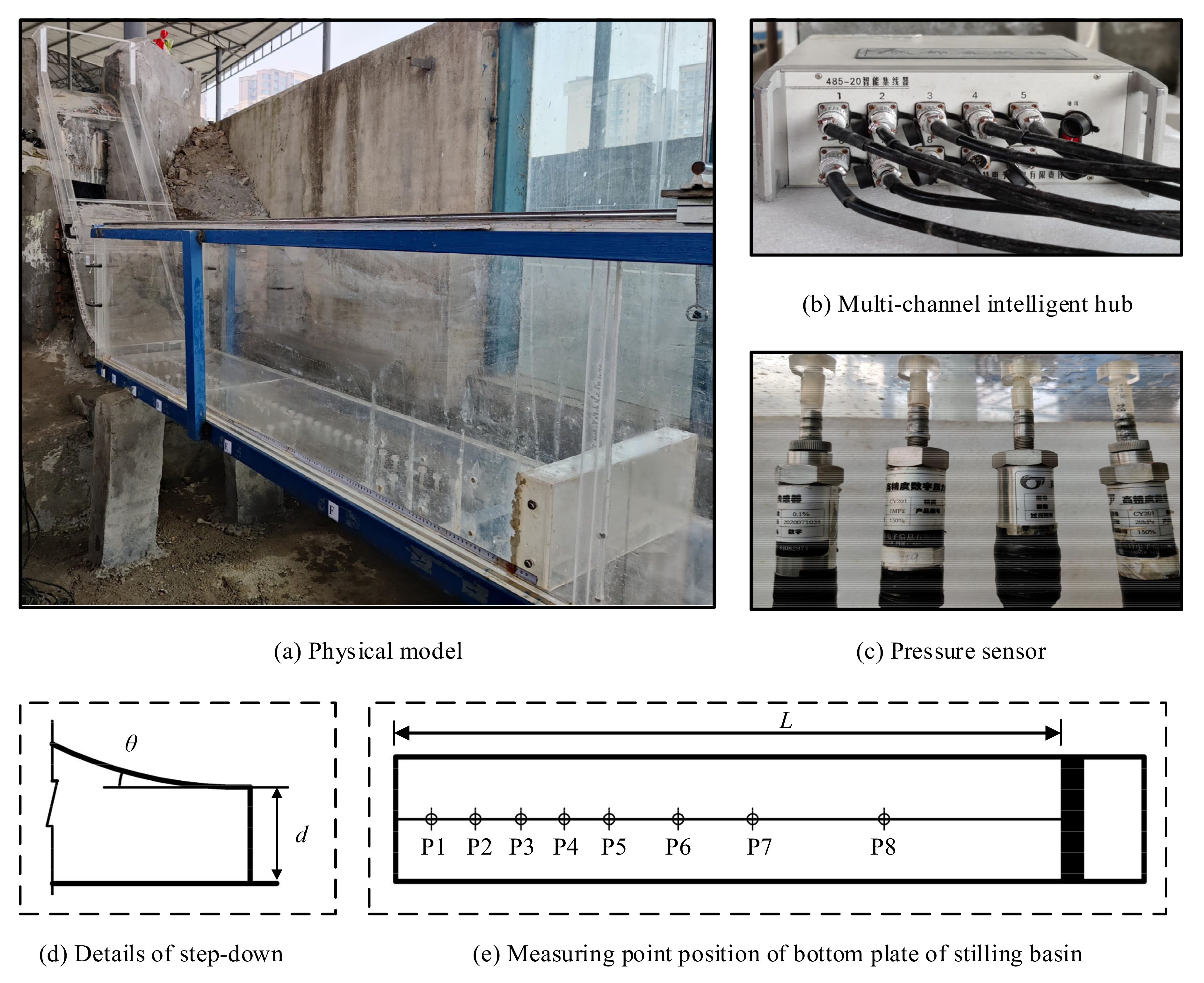
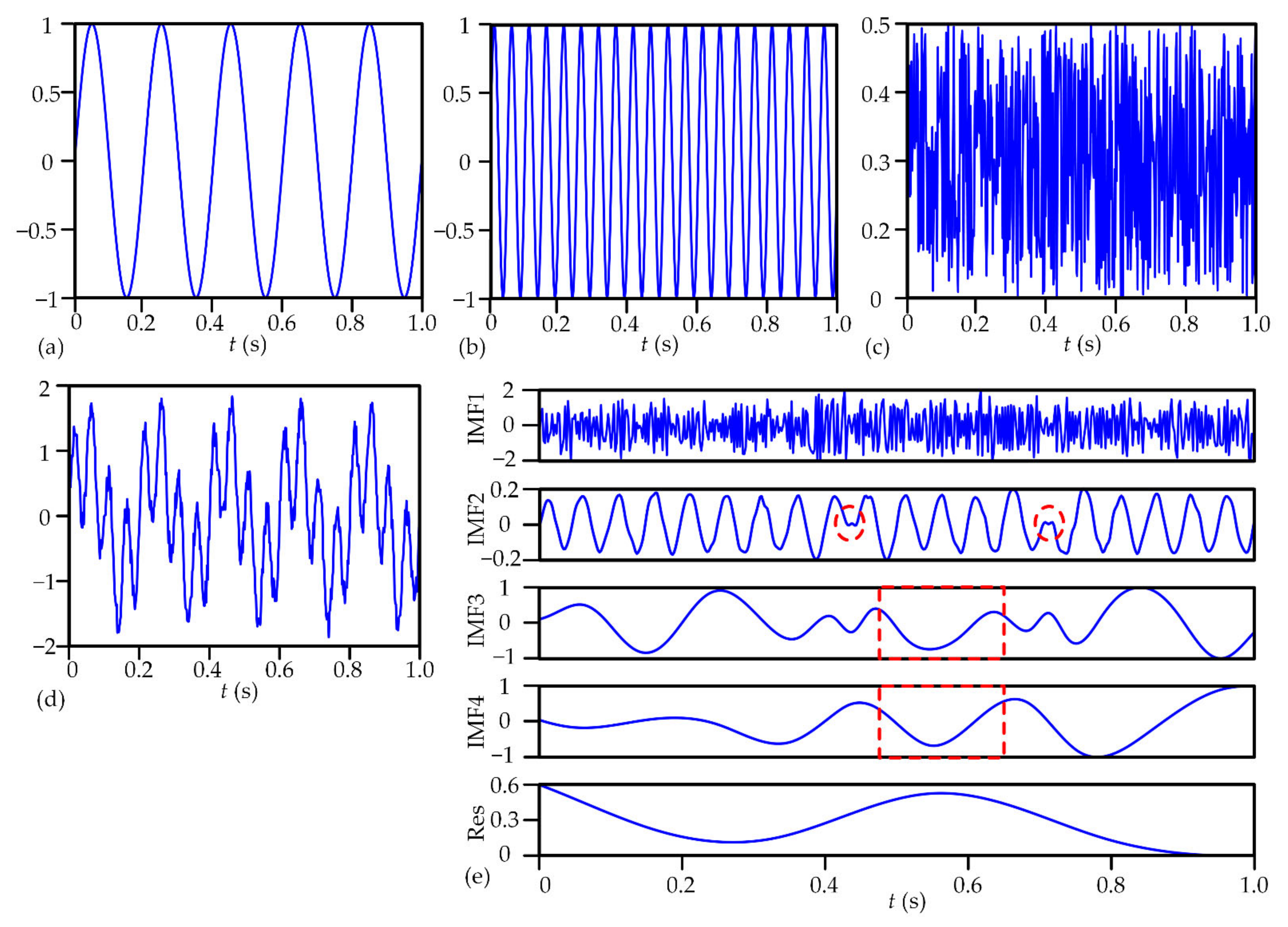

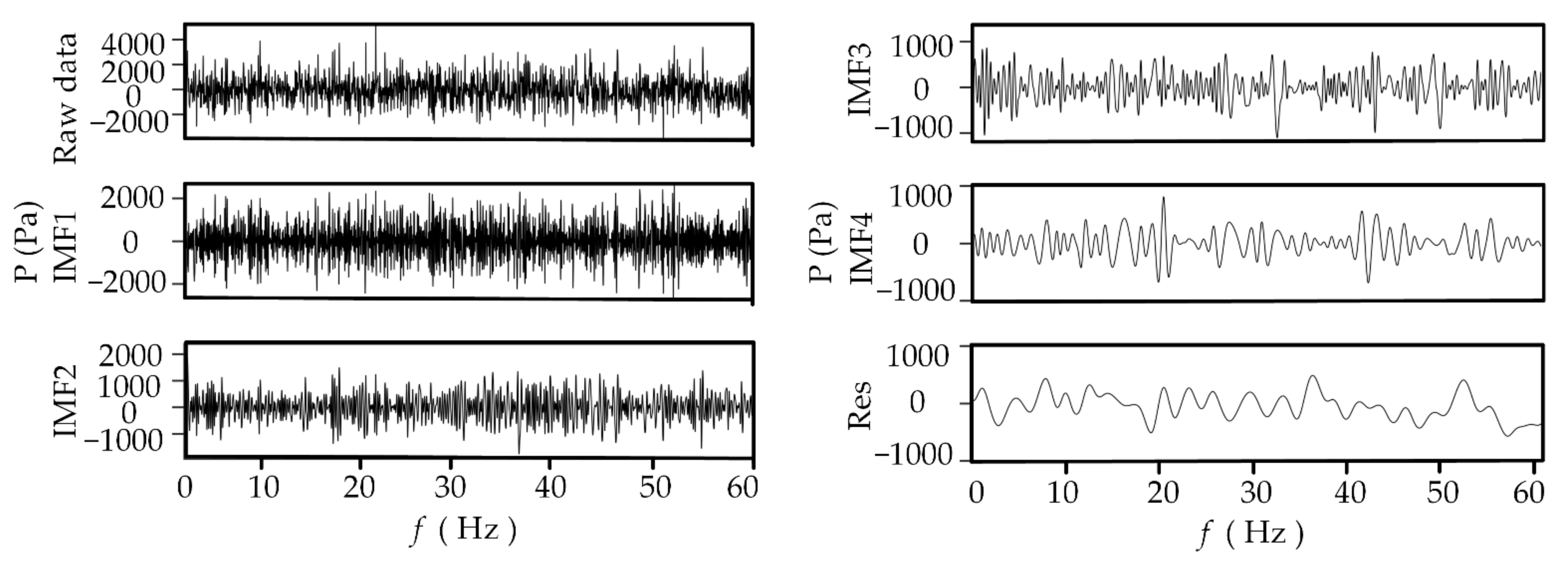
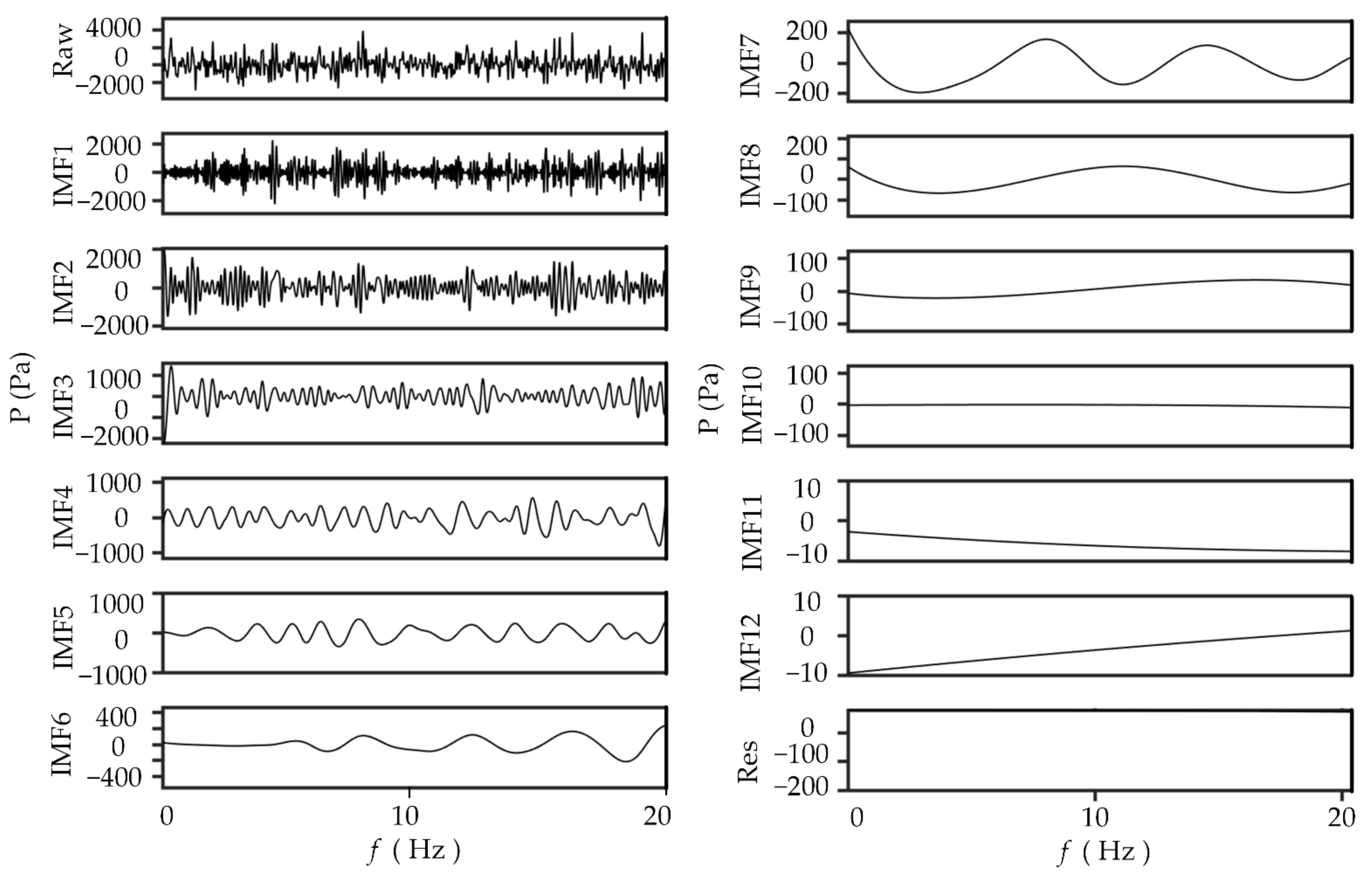
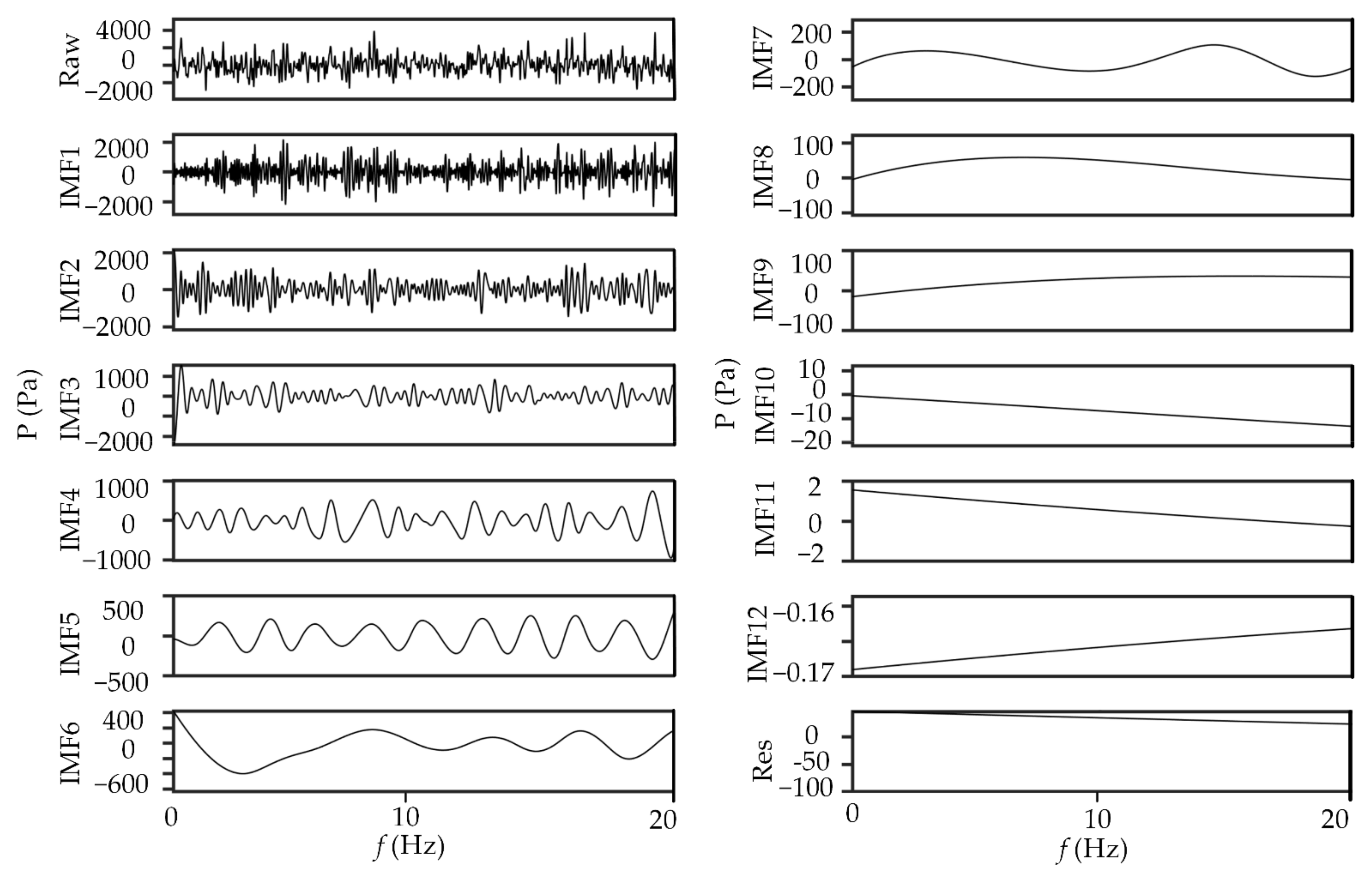
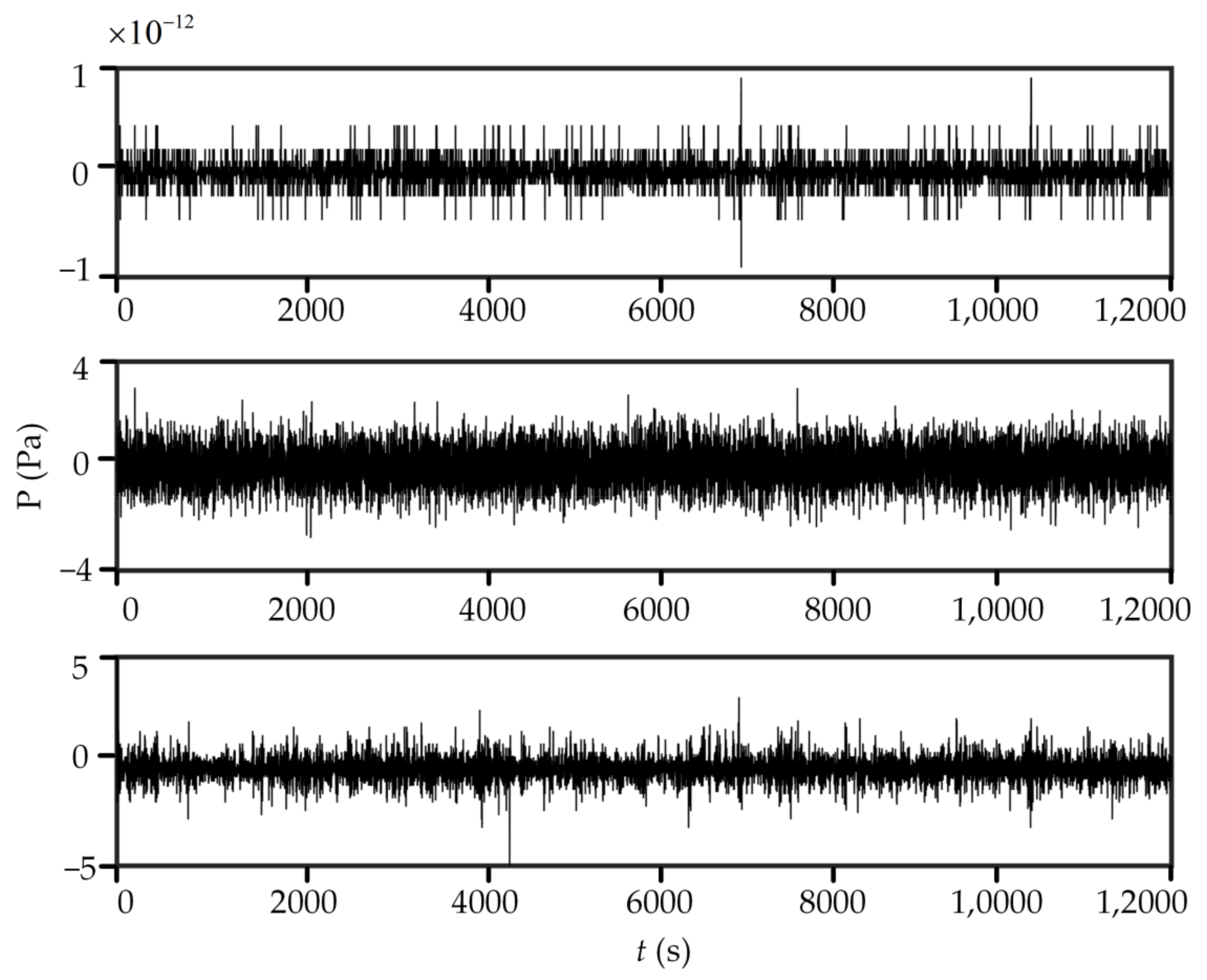
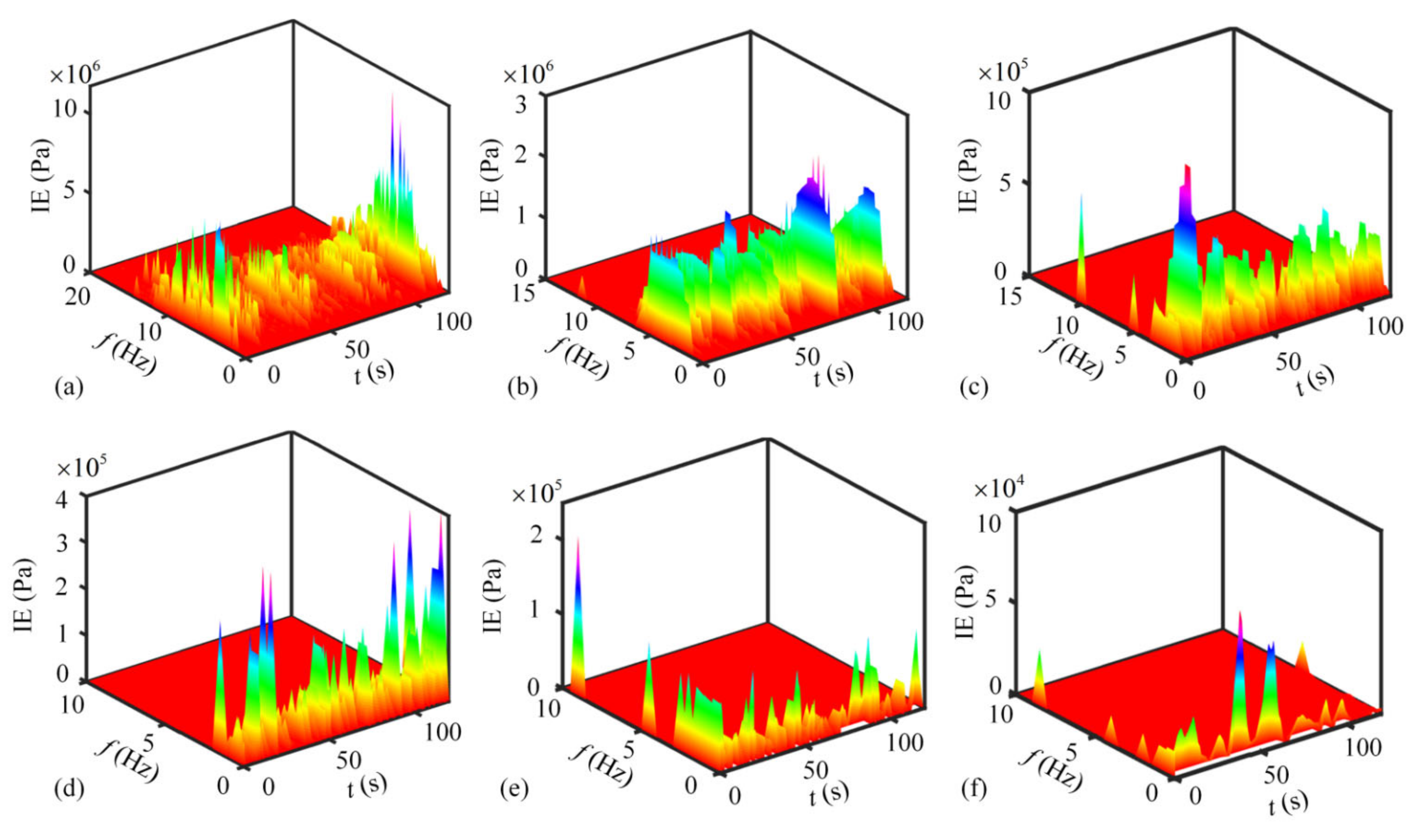
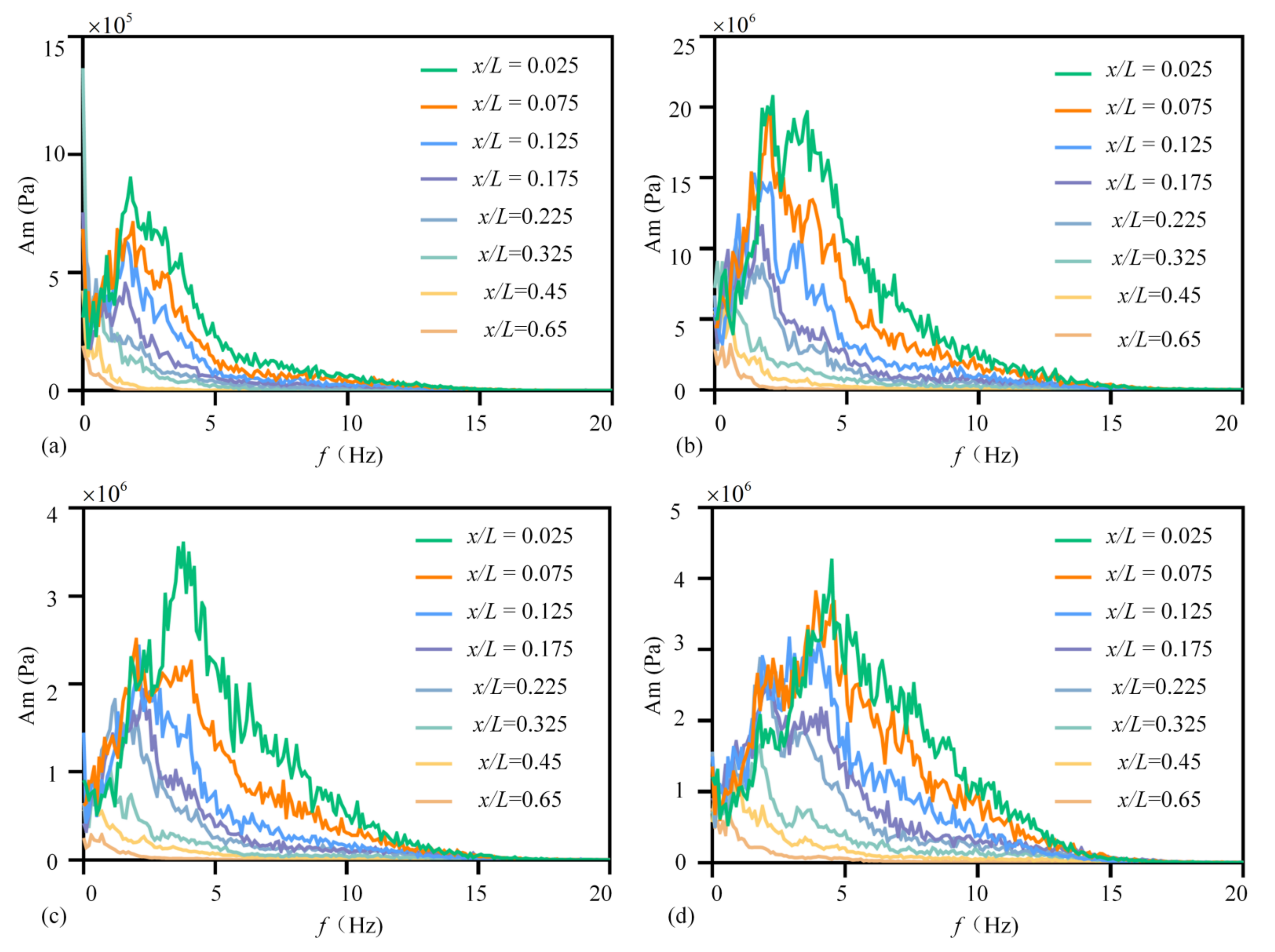
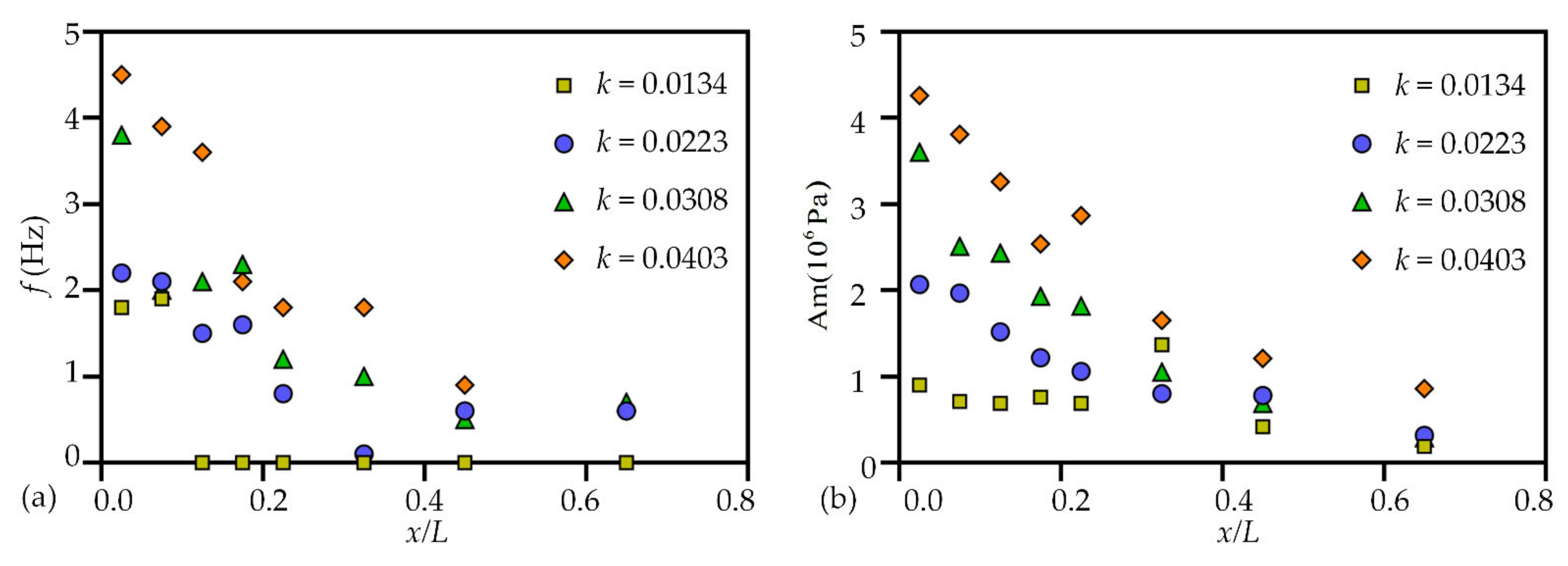
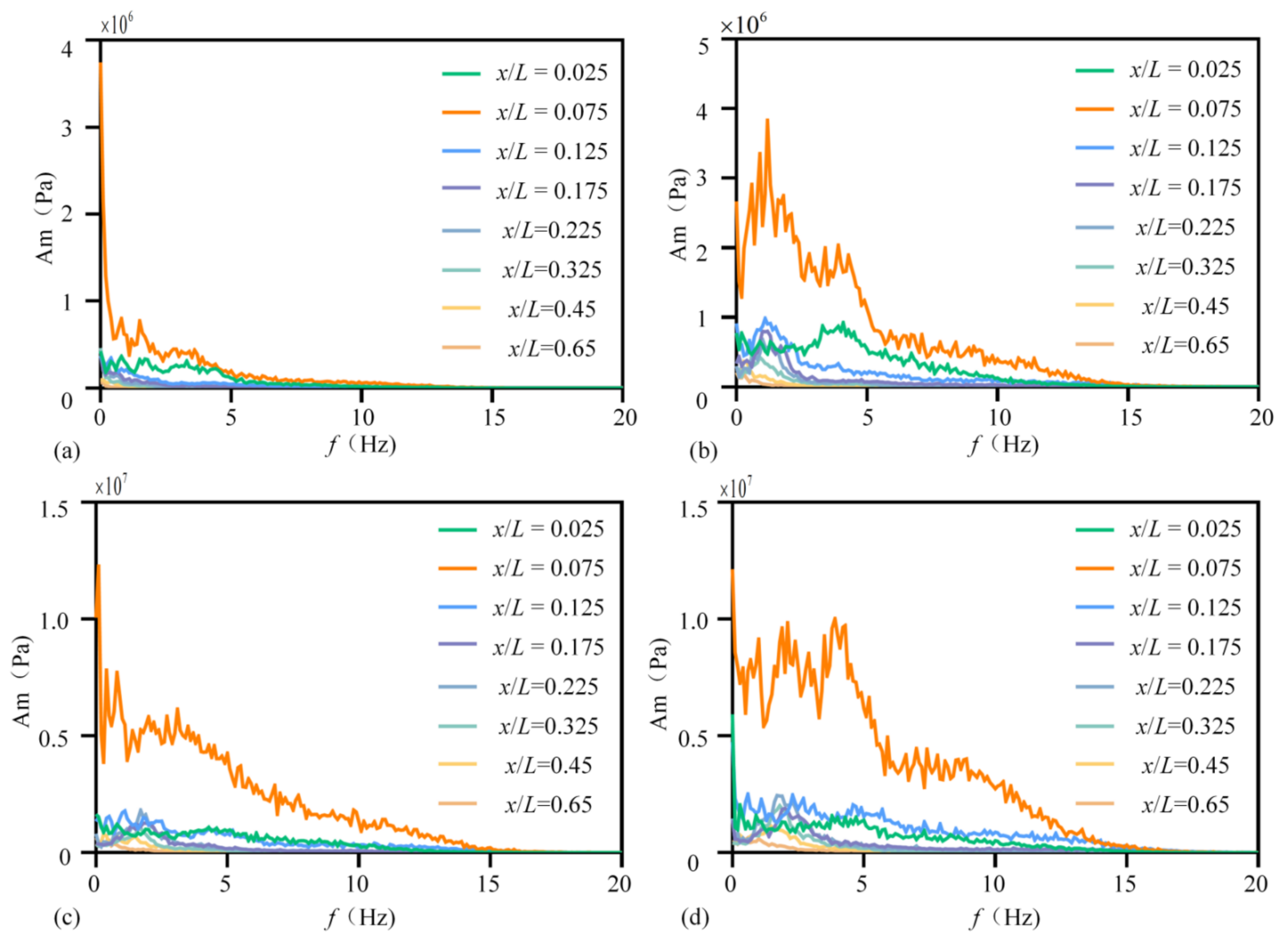
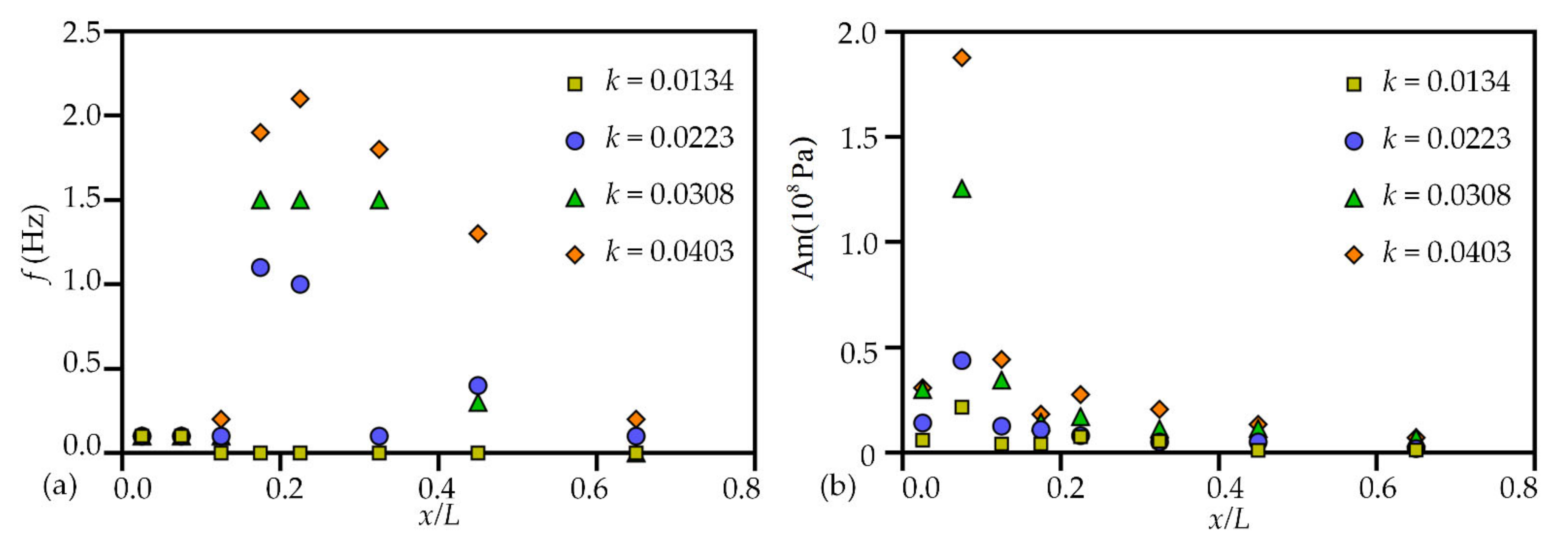
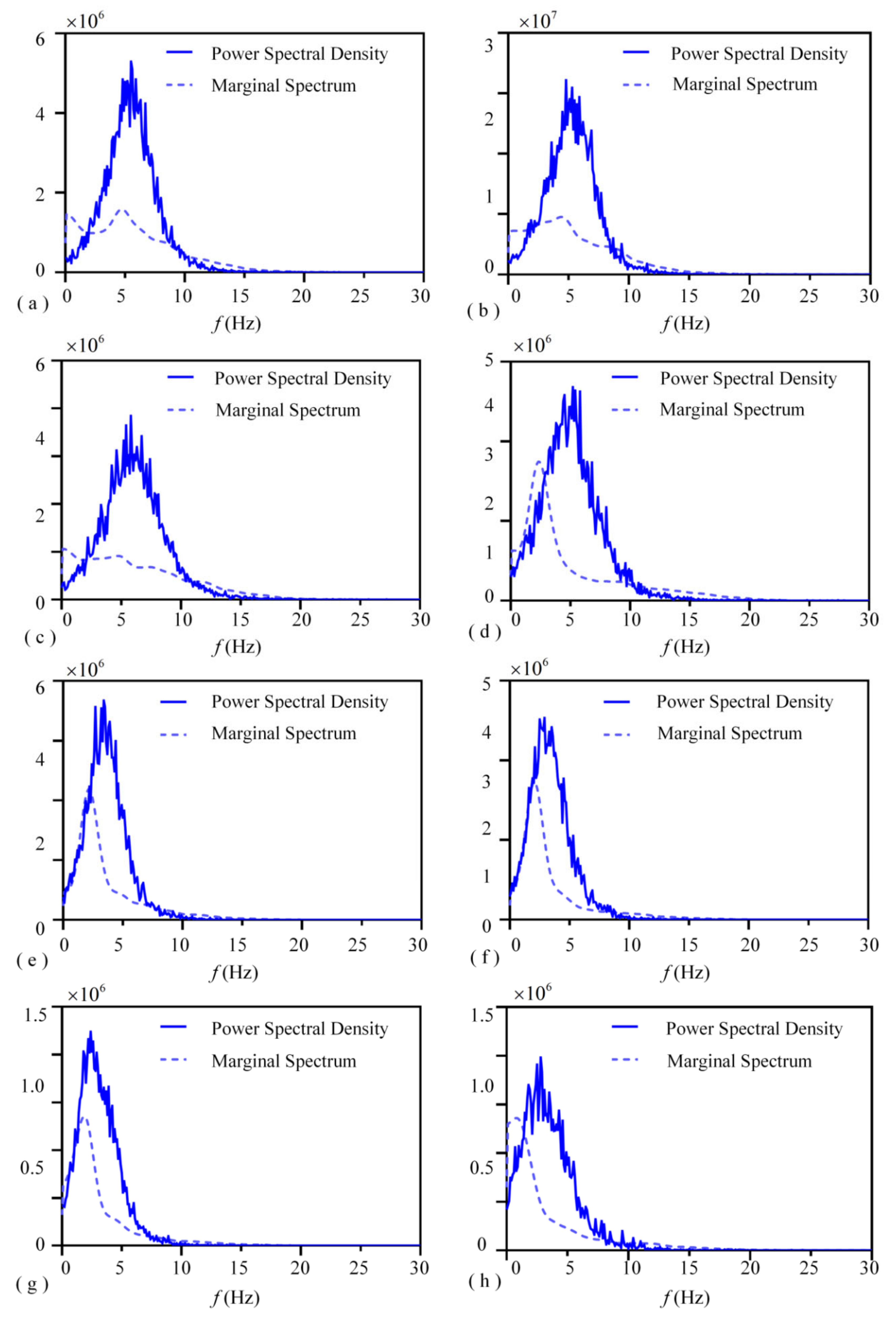
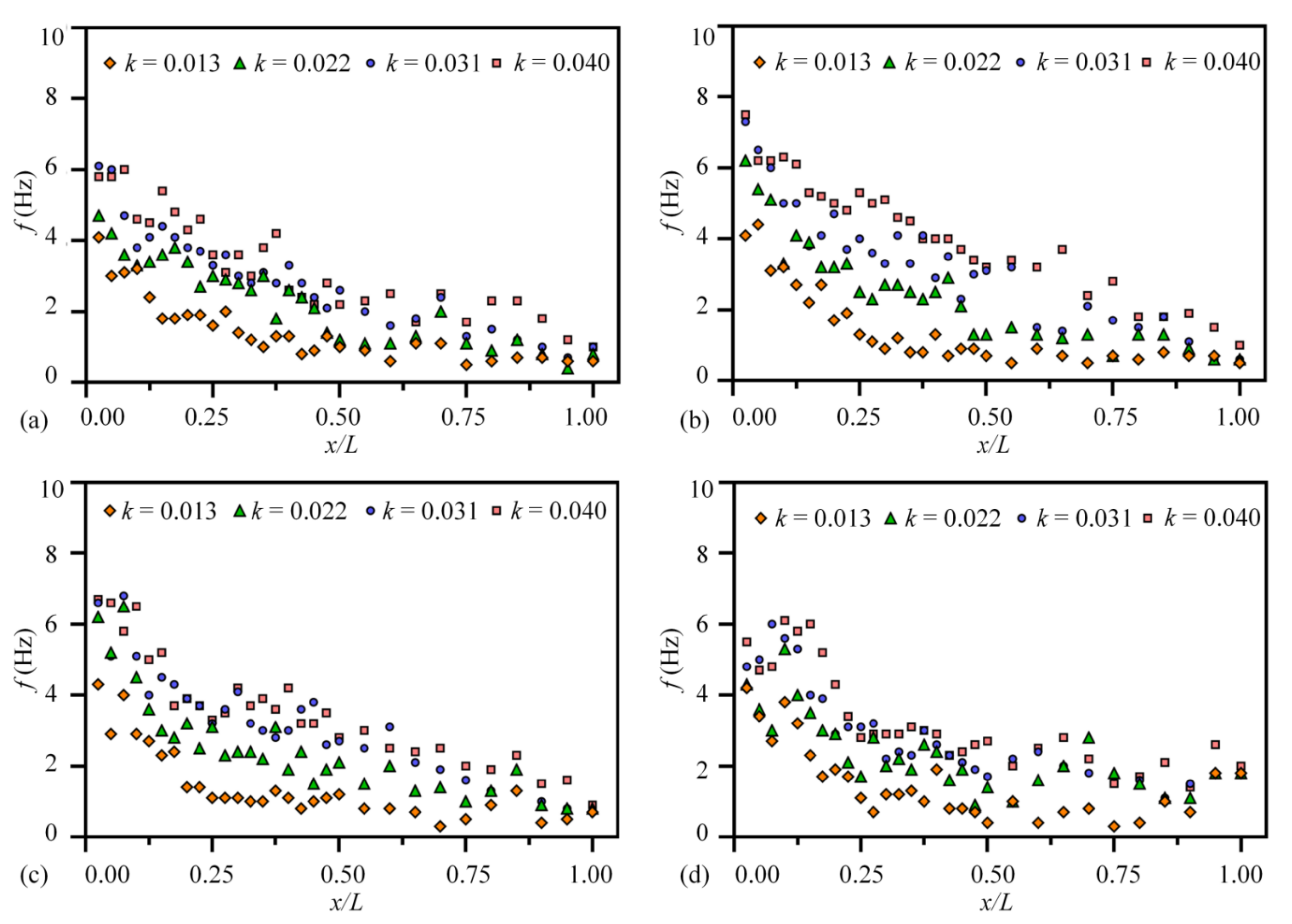
| Comparison Item | Fourier | Wavelet | HHT |
|---|---|---|---|
| Basis | a priori | a priori | a posteriori adaptive |
| Presentation | energy in frequency space | energy in time-frequency space | energy in time-frequency space |
| Nonlinearity | no | no | yes |
| Nonstationary | no | yes | yes |
| Feature extraction | no | Discrete, no; continuous, yes | yes |
| Theoretical base | complete mathematical theory | complete mathematical theory | empirical |
| Number of Measuring Points | x/m | Number of Measuring Points | x/m |
|---|---|---|---|
| P1 | 0.025 | P5 | 0.225 |
| P2 | 0.075 | P6 | 0.325 |
| P3 | 0.125 | P7 | 0.450 |
| P4 | 0.175 | P8 | 0.640 |
| Test Plan | Q (L/s) | q | H (m) | k |
|---|---|---|---|---|
| a | 30 | 0.06 | 131.12 | 0.0134 |
| b | 50 | 0.10 | 134.40 | 0.0223 |
| c | 70 | 0.14 | 136.88 | 0.0308 |
| d | 90 | 0.18 | 139.20 | 0.0403 |
| Test Plan | d (m) | θ (°) |
|---|---|---|
| TP 0 | 0 | 0 |
| TP 1 | 0.025 | 15 |
| TP 2 | 0.050 | 15 |
| TP 3 | 0.075 | 15 |
| TP 4 | 0.100 | 15 |
| Method | Overview of Methods and Principles | Major Advantage | Major Defect |
|---|---|---|---|
| EMD | Decomposition Based on Signal Properties | EMD Decomposition without Presetting Basis Function | Aliasing phenomenon and endpoint effect |
| EEMD | The added white noise offsets each other after integrated screening | Suppress modal confusion to some extent; Improving the Quality of IMF Decomposition | Large amount of computation and decomposition depends on adding white noise amplitude and integration times |
| CEEMD | Add opposite white noise to the target signal in pairs | Reduced reconstruction error greatly; Better elimination of auxiliary residual noise | Large amount of calculation, adding white noise parameter selection is not appropriate, may appear false component |
| Method | Add Noise Amplitude | Adding the Number of Noise | Index of Orthogonality |
|---|---|---|---|
| EMD | 0 | 0 | |
| EEMD | 0.01 | 200 | |
| CEEMD | 0.01 | 200 |
| IMF | x/L = 0.025 | x/L = 0.075 | x/L = 0.125 | x/L = 0.175 | x/L = 0.225 | x/L = 0.325 | x/L = 0.45 | x/L = 0.65 |
|---|---|---|---|---|---|---|---|---|
| IMF1 | 201,359.7 | 1,039,047.8 | 291,110.8 | 60,200.9 | 46,389.5 | 26,941.2 | 16,658.3 | 10,080.6 |
| IMF2 | 131,046.4 | 905,789.8 | 215,922.7 | 79,423.8 | 125,754.5 | 84,511.2 | 43,321.4 | 13,802.9 |
| IMF3 | 556,68.0 | 443,704.3 | 117,309.4 | 85,345.5 | 66,837.5 | 51,122.8 | 41,138.7 | 18,012.7 |
| IMF13 | 11,405.1 | 5231.9 | 8943.7 | 927.0 | 3204.6 | 181.6 | 176.4 | 417.0 |
| Sum | 472,788.4 | 2,745,517.5 | 743,726.6 | 264,555.3 | 266,273.1 | 183,756.1 | 124,636.0 | 65,125.7 |
| Original variance | 456,207.8 | 2,794,908.8 | 765,561.3 | 279,251.3 | 261,882.2 | 198,237.3 | 135,588.3 | 70,413.6 |
| Error (%) | 3.6 | −1.8 | 0.0 | −0.1 | 0.0 | −0.1 | −0.1 | −0.1 |
Publisher’s Note: MDPI stays neutral with regard to jurisdictional claims in published maps and institutional affiliations. |
© 2021 by the authors. Licensee MDPI, Basel, Switzerland. This article is an open access article distributed under the terms and conditions of the Creative Commons Attribution (CC BY) license (https://creativecommons.org/licenses/by/4.0/).
Share and Cite
Jia, W.; Diao, M.; Jiang, L.; Huang, G. Fluctuating Characteristics of the Stilling Basin with a Negative Step Based on Hilbert-Huang Transform. Water 2021, 13, 2673. https://doi.org/10.3390/w13192673
Jia W, Diao M, Jiang L, Huang G. Fluctuating Characteristics of the Stilling Basin with a Negative Step Based on Hilbert-Huang Transform. Water. 2021; 13(19):2673. https://doi.org/10.3390/w13192673
Chicago/Turabian StyleJia, Wang, Mingjun Diao, Lei Jiang, and Guibing Huang. 2021. "Fluctuating Characteristics of the Stilling Basin with a Negative Step Based on Hilbert-Huang Transform" Water 13, no. 19: 2673. https://doi.org/10.3390/w13192673
APA StyleJia, W., Diao, M., Jiang, L., & Huang, G. (2021). Fluctuating Characteristics of the Stilling Basin with a Negative Step Based on Hilbert-Huang Transform. Water, 13(19), 2673. https://doi.org/10.3390/w13192673






